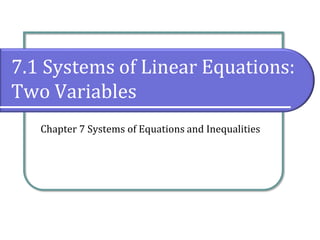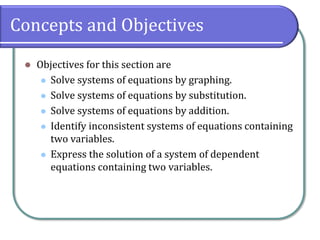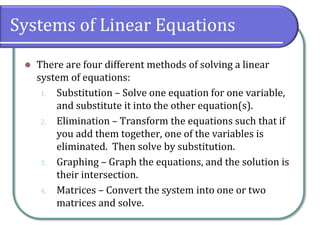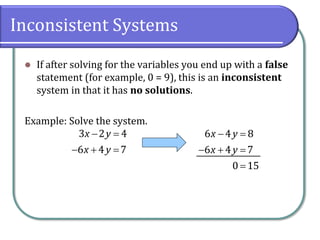7.1 Systems of Linear Equations - Two Variables
- 1. 7.1 Systems of Linear Equations: Two Variables Chapter 7 Systems of Equations and Inequalities
- 2. Concepts and Objectives ? Objectives for this section are ? Solve systems of equations by graphing. ? Solve systems of equations by substitution. ? Solve systems of equations by addition. ? Identify inconsistent systems of equations containing two variables. ? Express the solution of a system of dependent equations containing two variables.
- 3. Systems of Linear Equations ? A set of equations is called a system of equations. If all of the variables in all of the equations are of degree one, then the system is a linear system. In a linear system, there are three possibilities: ? There is a single solution that satifies all the equations. ? There is no single solution that satisfies all the equations. ? There are infinitely many solutions to the equations.
- 4. Systems of Linear Equations ? There are four different methods of solving a linear system of equations: 1. Substitution ¨C Solve one equation for one variable, and substitute it into the other equation(s). 2. Elimination ¨C Transform the equations such that if you add them together, one of the variables is eliminated. Then solve by substitution. 3. Graphing ¨C Graph the equations, and the solution is their intersection. 4. Matrices ¨C Convert the system into one or two matrices and solve.
- 5. Substitution Example: Solve the system. 1. Solving for y in the second equation will be simplest. 2. Now replace y with x + 3 in the first equation and solve for x. 3 2 11 3 x y x y + = ? + = 3 y x = + ( ) 3 2 11 3 2 6 11 5 5 1 3 x x x x x x + = + + = = = +
- 6. Substitution (cont.) 3. Now we replace x in the first equation with 1 and solve for y. 4. The solution is the ordered pair (1, 4). It is usually a good idea to check your answer against the original equations. ( ) 4 1 3 y y ? + = = ( ) ( ) ( ) 3 1 2 4 11 1 4 3 + = ? + =
- 7. Elimination (Addition) Example: Solve the system. While either variable would be simple to eliminate, multiplying the second equation by 4 would be simplest. 4 3 13 5 x y x y + = ? ? + = 4 3 13 4 4 20 x y x y + = ? ? + = 7 7 1 y y = = Be sure to multiply both sides! 1 5 4 4 x x x ? + = ? = = ? ( ) 4,1 ?
- 8. Inconsistent Systems ? If after solving for the variables you end up with a false statement (for example, 0 = 9), this is an inconsistent system in that it has no solutions. Example: Solve the system. 3 2 4 6 4 7 x y x y ? = ? + = 6 4 8 6 4 7 0 15 x y x y ? = ? + = =
- 9. Infinitely Many Solutions ? If after solving the variables you end up with a true statement (ex. 0 = 0), then you have a dependent system with infinitely many solutions. In this case, you would express your solution set in terms of one of the variables, usually y. Example: Solve the system. 4 2 4 2 0 0 x y x y ? = ? ? + = = 4 2 2 4 x y y x = ? ? = 2 , 4 y y ? ? ? ? ? ? ?
- 10. Classwork ? College Algebra 2e ? 7.1: 8-40 (x4); 6.7: 24-36 (even); 6.6: 68-76 (even) ? 7.1 Classwork Check ? Quiz 6.7









